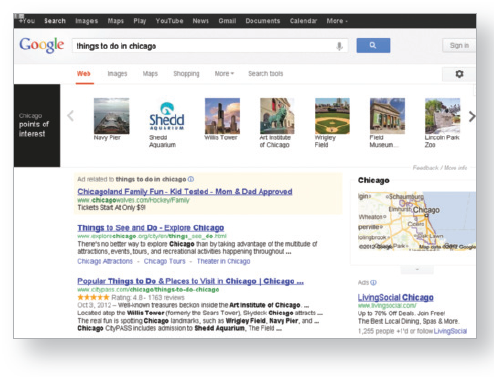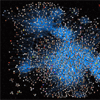Avoid a Knowledge Graph-tastrophe

The search experience at Google has changed dramatically over the past few years.
While the factors used today by the search engine to determine placement on its results pages aim to deliver an enriched user experience, it has made the process of natural or organic search optimization an infinitely more complicated and challenging undertaking for digital marketers.
What Is Google Doing to Us?
When Google announced its Knowledge Graph initiative back in May 2012, search engine optimization professionals (SEO's) across the Web started to worry. They worried that the top organic listings they worked so diligently to establish would be pushed down the results page. They also worried that big brands would ultimately not just control more virtual real estate, but also, in many respects, completely dominate and overshadow their smaller (and perhaps less savvy) competitors. For some, that's already happening.
But the situation is getting worse. In early Oct. 2012, Google formally released its Product Listing Ads (read more on page 36) and the very next month "spiffed" up its search result pages with a new navigation bar. Both of these announcements, you guessed it, pushed those coveted first-page listings even farther down the fold (sometimes out of view completely). It is almost as if Google has a virtual vendetta against anyone who ever optimized their site for higher placement on search results.
If Google's recent set of changes has your SEO team flustered and fearing for the long-term sustainability of your digital enterprise, know that understanding what the Knowledge Graph is and how it works can provide some virtual relief.
Understanding the Knowledge Graph
From a high level, the Knowledge Graph is Google's attempt to provide information instead of, or rather than, websites alone. As you might imagine, the "knowledge" can come in a variety of forms (from a one-line answer to a micro-biography or an organizational profile). These developments are intended to make search more intelligent and accessible.
With information on hundreds of millions of people, places and things, Google's Knowledge Graph initiative isn't just about aggregating, indexing and ranking data, but is also about taking action upon the attributes of data that enables Google to better understand connections and make the information more useful and meaningful to an end-user. For example, if a user searches for "things to do in Chicago," they will encounter an image carousel that consistently sources information from Wikipedia, an authoritative, well-cited 'Net destination, and contains images of popular destinations in Chicago (see image).
Understand that, today, content needs to be correlated, connected and shared by authorities to top the search results pages.
(article continues below)

Solutions for Search Salvation
Every enterprise on the Web is concerned with the constantly shifting state of SEO best practices. It is being transformed right before your digital-loving eyes and in significant, business altering ways. The strategies employed today are wildly different than those used even a few short years ago. Fortunately, it is possible to, at least in part, avoid a Knowledge Graph-tastrophe. Consider future proofing your SEO with the following strategies:
Google+ Correlation:
The path toward avoiding a Knowledge Graph-tastrophe moves squarely through Google+. Digital marketing and analytics vendor Fathom conducted a study recently that examined the top-100 brands as defined by Millward Brown's 2012 BrandZ List. What was found may surprise you. Only 24 percent of the top-100 brands examined triggered a Knowledge Graph entry when searched, and the information for 92 percent of those entries came directly from Google+ (the remainder came from Wikipedia). You'll be hard pressed to find more convincing evidence that creating a Google+ page is fundamental to future proofing your SEO campaigns.
MicroData Inclusion:
If there is one area where Google needs the help and support of SEO's, in relation to success with its Knowledge Graph, it is in the use of microdata. Remember, Google's aspirations are to evolve from a search engine into a knowledge engine, and it can't do that with sparse levels of data. Google needs Web marketers, designers/developers and, of course, SEO's to use more structured markup, as it enables the knowledge engine to better correlate a Web page to the intent of a user/searcher. This, in turn, makes it easy for Google to determine relevance. To stay alive on the SERPs in 2013 and beyond, you'll need to focus on supporting more types of microdata on your digital property including types for reviews, people, products, events and, yes, even authorship markup.
"The (SEO) strategies employed today are wildly different than those used even a few short years ago. Fortunately, it is possible to, at least in part, avoid a Knowledge Graph-tastrophe."
Asset Universality:
Let's hope you're not just using traditional "content" in your SEO efforts. If there is anything that Google's SERP shuffles over the past 18 months have taught SEO's, it is that using a variety of assets (blogs, videos, places, books, etc.) proves incredibly useful to securing search positions. One of the more feasible strategies is something we've discussed previously within the pages of Website Magazine's Mastering Search column - re-optimization or content re-purposing. For example, if you have spent resources (time or money) on blogging the past few years, revisit that content and determine ways to transform it into videos or infographics.
Authoritative Citations:
Perhaps more than any other strategy referenced here, the acquisition of authoritative citations remains the single most important factor in generating competitive positions on the SERPs. All data on the Web is inter-linked and has relationships, and these signals establish your Web presence. How well you refer to other sites with relevant content and how many sites refer back to the content - considering it a valuable resource - determine the inter-connectivity of data and documents. Other social signals, such as shares, likes, +1s, etc. quantify these signals.
Avoid a Knowledge Graph-tastrophe
From Penguin to Panda and every index refresh in between and after, you've likely felt the impact of Google's seemingly constant algorithm changes in the recent past. As the search engine refocuses its energy and resources on providing an improved experience for endusers, SEO's may suffer the most. To avoid a Knowledge Graph-tastrophe focus on more and better Google+ participation. You should also accelerate the integration of microdata, expand the types and depth of content and creative assets and pursue the most authoritative inbound links possible.









